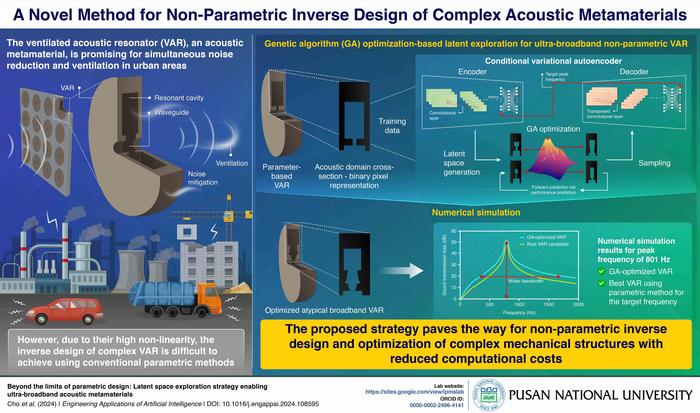Noise pollution has become increasingly common in urban areas, stemming from traffic, construction activities, and factories, which can seriously impact health, causing stress, sleep disturbances, and cardiovascular issues. Consequently, various methods for noise reduction have been proposed, such as physically blocking the path of sound and active noise control. However, since sound travels through air, physically blocking sound can also lead to poor ventilation, highlighting the need for research into simultaneous sound attenuation and ventilation.

Credit: Sang Min Park from Pusan National University
Noise pollution has become increasingly common in urban areas, stemming from traffic, construction activities, and factories, which can seriously impact health, causing stress, sleep disturbances, and cardiovascular issues. Consequently, various methods for noise reduction have been proposed, such as physically blocking the path of sound and active noise control. However, since sound travels through air, physically blocking sound can also lead to poor ventilation, highlighting the need for research into simultaneous sound attenuation and ventilation.
Acoustic metamaterials (AMs) have been extensively studied as a promising solution for this purpose owing to their unique acoustic properties. Recently a new type of AM, called a ventilated acoustic resonator (VAR), has been proposed that can manipulate both sound waves and airflow using only geometric shapes. It can block even low-frequency noise with a compact structure while maintaining ventilation. A VAR consists of a waveguide that guides sound waves to a resonant cavity that traps them. For appropriate performance, a VAR requires a functional shape optimized for broadband sound attenuation across a target peak frequency. However, conventional analytical design methods only allow relatively simple parametric designs and cannot be used for achieving VARs with complex geometries.
To address this limitation, a team of researchers from Korea, led by Associate Professor Sang Min Park from the School of Mechanical Engineering at Pusan National University developed an innovative deep-learning-based inverse design method. “We proposed a latent-space exploration strategy that searches for broadband VAR with the target frequency through genetic algorithm-based optimization. Compared to conventional methods, our approach allows for high design flexibility while reducing computational costs,” explains Dr. Park. Their study was made available online on May 15, 2024, and published in Volume 133, Part F of the journal Engineering Applications of Artificial Intelligence in July 2024.
In the proposed inverse design method, a conditional variational autoencoder (CVAE), a deep-learning generative model, encodes the geometric features of the VAR in the latent space. The latent space is a lower-dimensional space that contains the essential information of a higher-dimensional input, in this case, the VAR. To generate this space, the CVAE is trained with cross-section images of the resonant cavity of VAR and peak frequency information. The generated latent space is then used for genetic algorithm (GA) optimization, aimed at searching for a VAR with broadband sound attenuation performance for various peak target frequencies. GA applies a natural-selection-based approach to search for optimized VAR over multiple successive generations, much like the selection of favorable genes in biological evolution.
The researchers trained the CVAE with cross-section images of VAR with a T-shaped resonant cavity with varying values for its design parameters. Using this data, their optimization strategy produced a non-parametric VAR with an atypical but functional structure. The researchers compared the optimization results with the VAR having the widest bandwidth in the training data for each target frequency and found that the optimized designs exhibited broader bandwidths in all cases. Furthermore, they compared the performance of the non-parametric VAR to that designed using a parameter-based inverse design method and found that the former had considerably larger bandwidths.
Highlighting the significance of these results, Dr. Park says, “Our ultra-broadband VARs can be deployed in urban environments to effectively reduce noise pollution without compromising ventilation, thereby improving quality of life by creating quieter, more comfortable living and working spaces. Additionally, our strategy opens new horizons for artificial-intelligence-based design of complex mechanical structures, potentially revolutionizing fields like automotive and aerospace engineering.”
This pioneering design method represents a significant step towards the AI-driven design of AMs and other complex mechanical structures.
***
Reference
Title of original paper: Beyond the limits of parametric design: Latent space exploration strategy enabling ultra-broadband acoustic metamaterials
Journal: Engineering Applications of Artificial Intelligence
DOI: https://doi.org/10.1016/j.engappai.2024.108595
About the institute
Pusan National University, located in Busan, South Korea, was founded in 1946 and is now the No. 1 national university of South Korea in research and educational competency. The multi-campus university also has other smaller campuses in Yangsan, Miryang, and Ami. The university prides itself on the principles of truth, freedom, and service, and has approximately 30,000 students, 1200 professors, and 750 faculty members. The university is composed of 14 colleges (schools) and one independent division, with 103 departments in all.
Website: https://www.pusan.ac.kr/eng/Main.do
About the author
Sang Min Park is currently an Associate Professor at the School of Mechanical Engineering, Pusan National University, South Korea. His group is focusing on developing an AI-driven structure inverse design and optimization framework and its application for enhancing the performance of nano-micro sensors, soft robotics, energy harvesting devices, and complex mechanical structures.
Lab Website: https://sites.google.com/view/ipmslab/
ORCID id: 0000-0002-2496-4141
Journal
Engineering Applications of Artificial Intelligence
DOI
10.1016/j.engappai.2024.108595
Method of Research
Computational simulation/modeling
Subject of Research
Not applicable
Article Title
Beyond the limits of parametric design: Latent space exploration strategy enabling ultra-broadband acoustic metamaterials
Article Publication Date
1-Jul-2024
COI Statement
The authors declare that they have no known competing financial interests or personal relationships that could have appeared to influence the work reported in this paper.




